It seems that Kevin Phillips and the North East are a footballing match. The former forward enjoyed arguably his best playing days in the Premier League with Sunderland. While in his first managerial appointment, he guided South Shields to promotion to National League North.
He left the Tyneside-based club having won an impressive 58% of his matches in charge. His achievements didn’t go unnoticed. Although he left his position at South Shields by reported mutual consent, Phillips is back in the dugout in the North East – this time at National League side Hartlepool United.
Following relegation from EFL League Two last season, Hartlepool had hoped to be in the promotion picture this campaign. Despite a promising start to the season, winning five of their first seven fixtures, things took a turn for the worse as the Pools went on to win three of the next 19, including 12 defeats.
When Phillips was appointed, Hartlepool found themselves in 16th position, only four points from the drop zone and 10 adrift of the playoff places. However, since Phillips’ arrival, at the time of writing, Hartlepool has turned the tide, currently occupying 10th place. The Monkey Hangers are only six points from the playoffs and nine points above the relegation places.
This tactical analysis will look to assess Hartlepool’s change in form. We will provide an analysis of Phillips’ tactics to establish how he has architected the Pools rise up the table.
A club on the rise
Since his appointment in January 2024, Phillips has overseen six league games in charge at Hartlepool, only suffering one defeat and winning an impressive four of those fixtures.
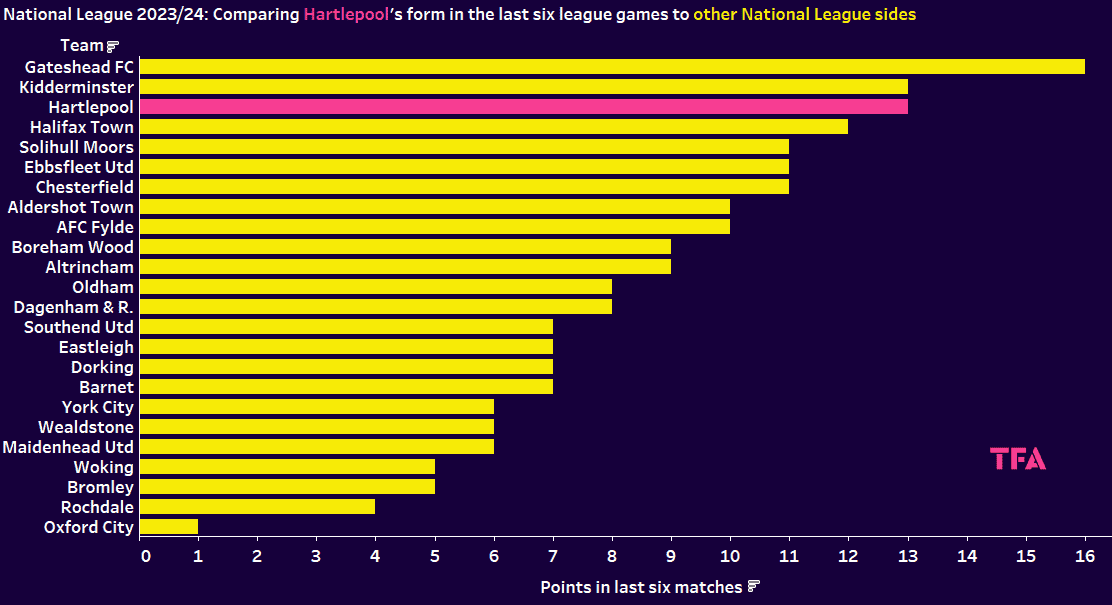
With such top statistics, it is not too surprising that the Pools are one of the form teams in the division, as shown in the above graph. Only Gateshead has collected more points in the last six fixtures.
During these last six fixtures, Hartlepool has been averaging 2.17 points per match. If Phillips’ side can keep this rate up for the 10 remaining fixtures, the Pools can expect to finish the season on 68 points. Whilst this tally would prove to fall slightly short of the playoffs in the past few seasons, it wouldn’t be too far behind. Therefore, there is every chance that Hartlepool could still put themselves in contention for an immediate return to the football league.
Moreover, if you consider that in the six league fixtures prior to Phillips’ arrival, Hartlepool was averaging just one point per match, there are certainly promising signs that the Pools could be competing at the right side of the division next season.
In further encouragement for the Victoria Park faithful, it is not just the points per match that have improved since Phillips’ appointment.

The above table shows that in the six matches before Phillips’ appointment, Hartlepool scored much fewer goals per match. Furthermore, although not a huge improvement from a defensive point of view under Phillips, there has been an improvement at Hartlepool nonetheless. The statistics point to a club heading in the right direction.
Change in defensive mindset
One of Hartlepool’s downfalls this season has been their defence, as they have only kept two clean sheets in the league – the lowest in the division – accounting for 5.6% of their fixtures. Although the Pools are yet to keep a clean sheet under Phillips, there has been progress in the backline.
There has been a marked improvement if you factor in that Hartlepool has conceded 1.33 goals per match with Phillips in the dugout, compared to an average of 1.87 goals conceded per match, accounting for all league games prior to Phillips’ appointment.
Phillips’ is not rigid with his formation choice as he has used three different formations in his opening six fixtures. Hartlepool has altered between a 4-2-3-1, 4-4-1-1, and a 3-5-2 but has tended to favour the 4-2-3-1, utilising this shape in 50% of Phillips’ matches.
The Pools have become much more disciplined in keeping their shape, and their defensive line has dropped much deeper under Phillips, adopting a low block. This, in turn, has led to a less aggressive press.
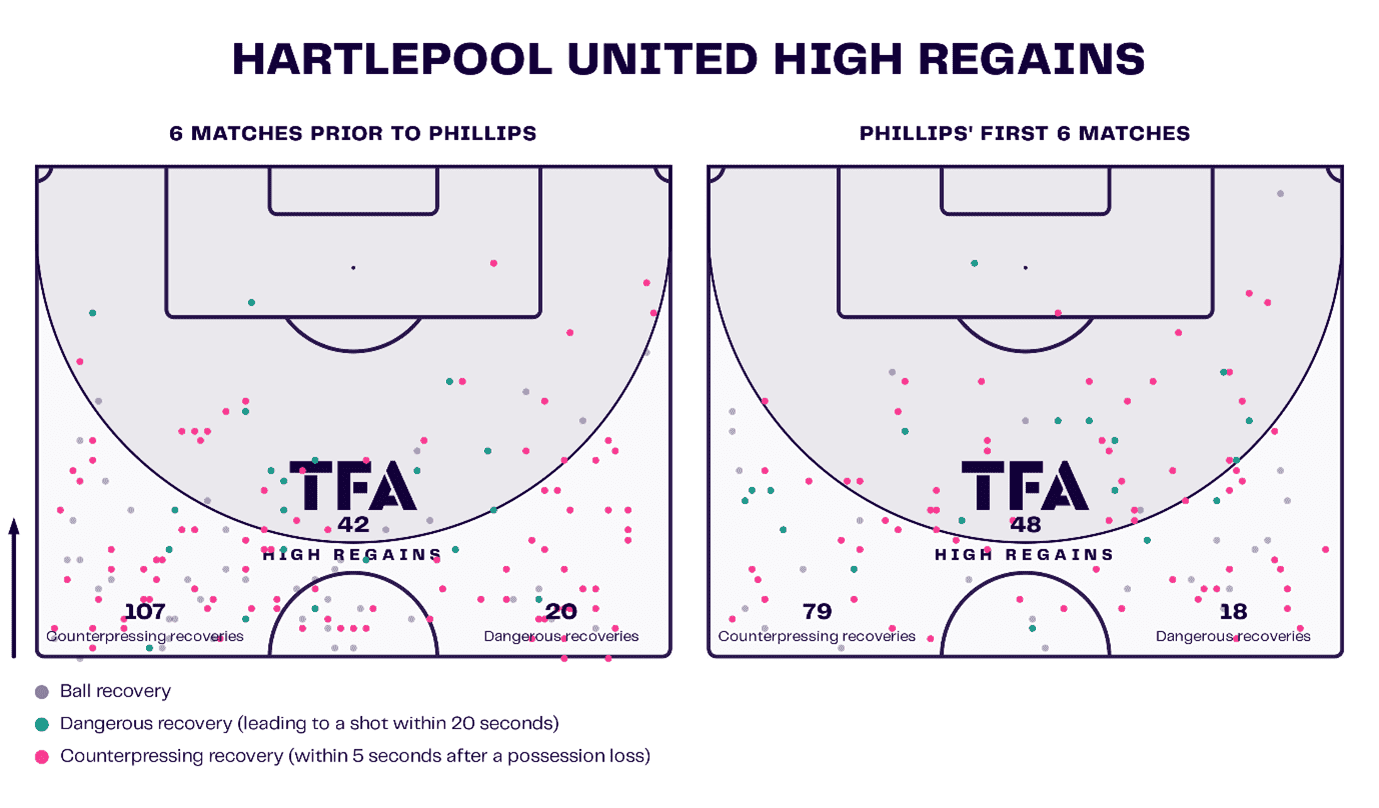
It’s notable that while they’ve completed a similar number of high regains and dangerous recoveries under Phillips as they had completed in their previous six games before his arrival, their approach to counterpressing has changed dramatically, with Phillips looking to sit deep and counter from there more compared to before when Hartlepool would look to force high turnovers.
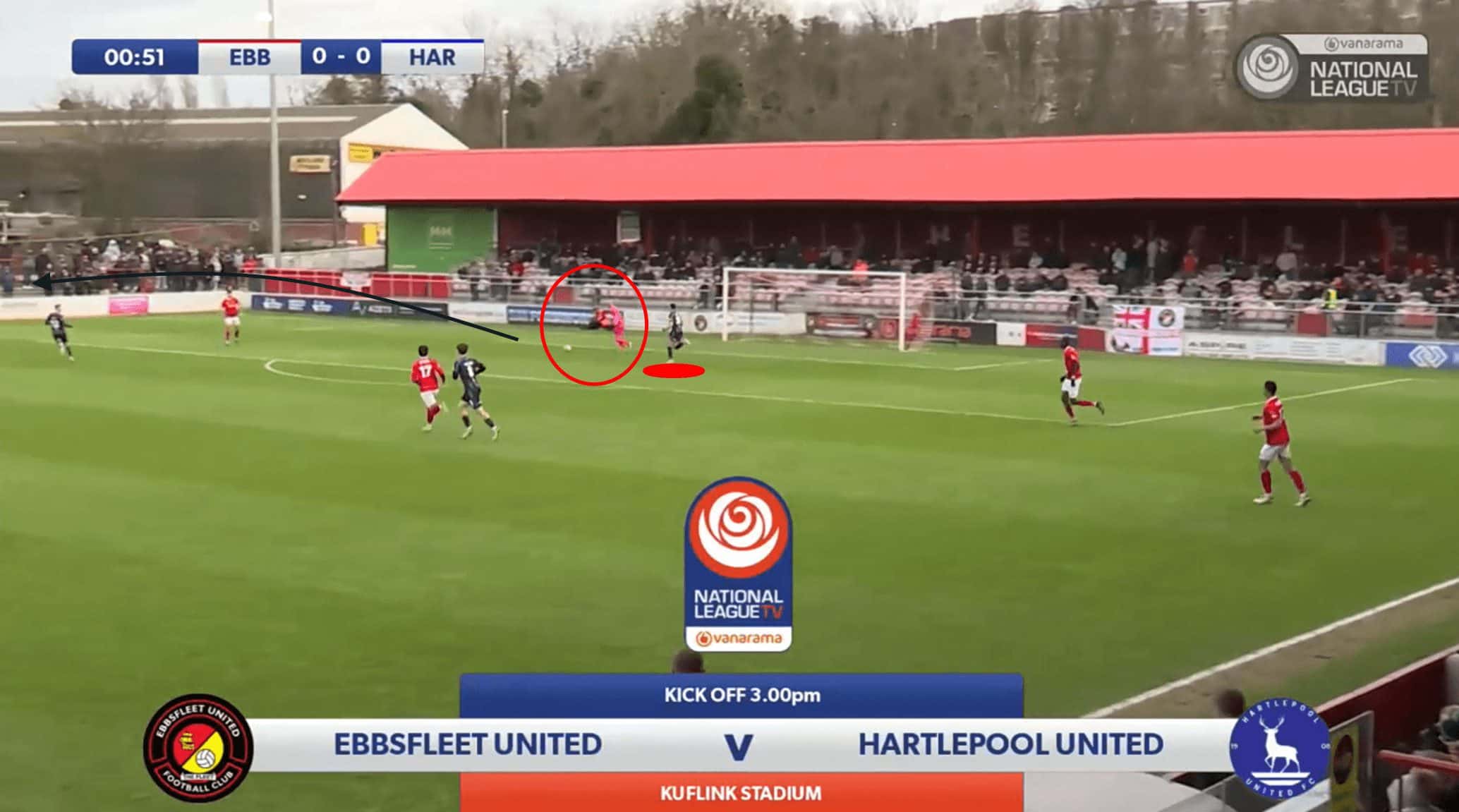
Above is an example of Hartlepool’s press before Phillips arrived in the dugout. The front forward presses more intensely, and Hartlepool shifts positioning to the left as a team. However, the Ebbsfleet goalkeeper is able to pick out a well-distributed pass.
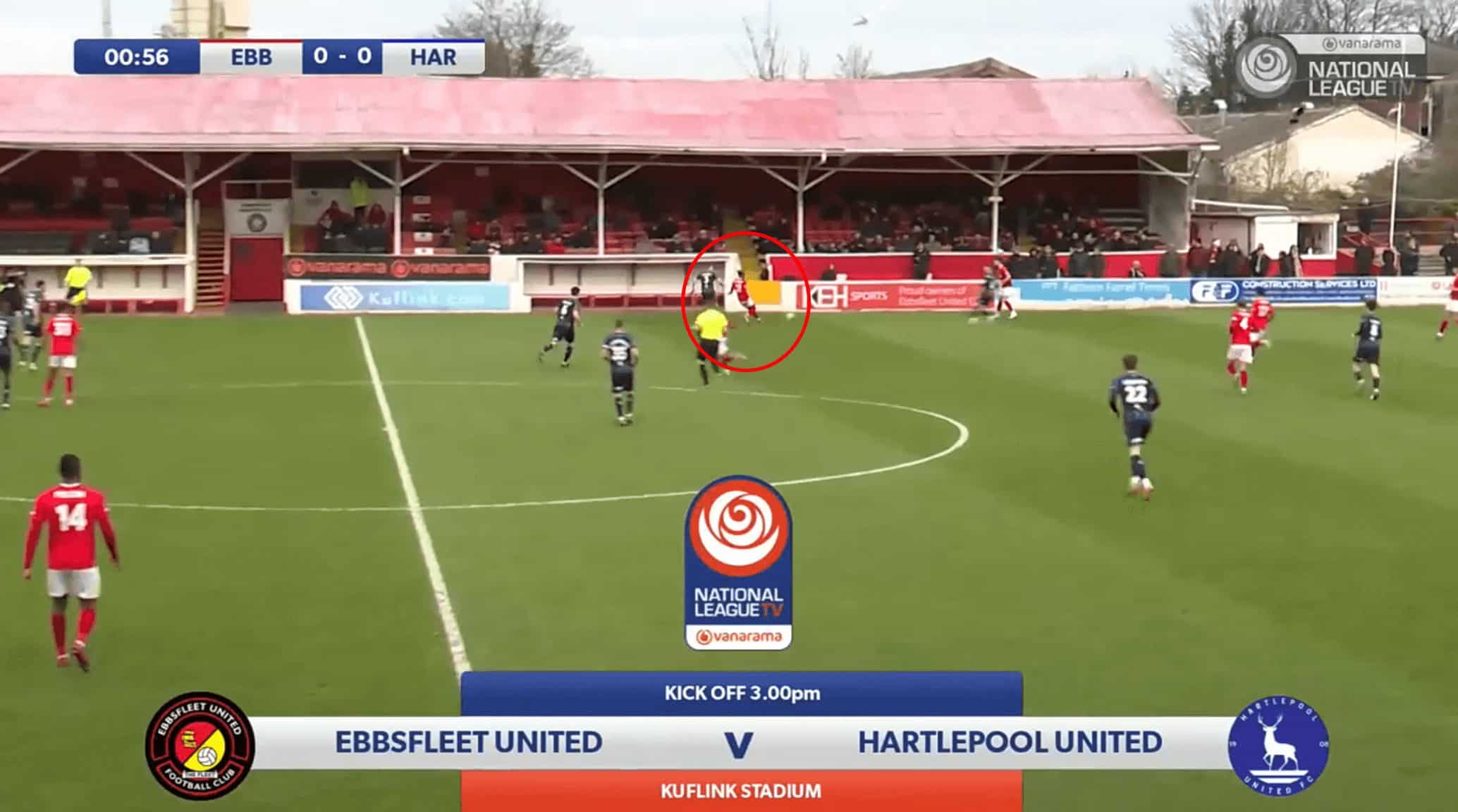
The weight of the pass ensures the ball bypasses three Hartlepool players. Following some passing exchanges, Ebbsfleet are able to work possession down the right-hand channel. Although nothing came of the eventual attack, this exemplifies how teams can break through a high press and leave their opponents potentially vulnerable.
In contrast, the North East outfit is more content to sit deeper and soak up the pressure these days. As a result, they have recorded a higher number of low recoveries in the past six league encounters.
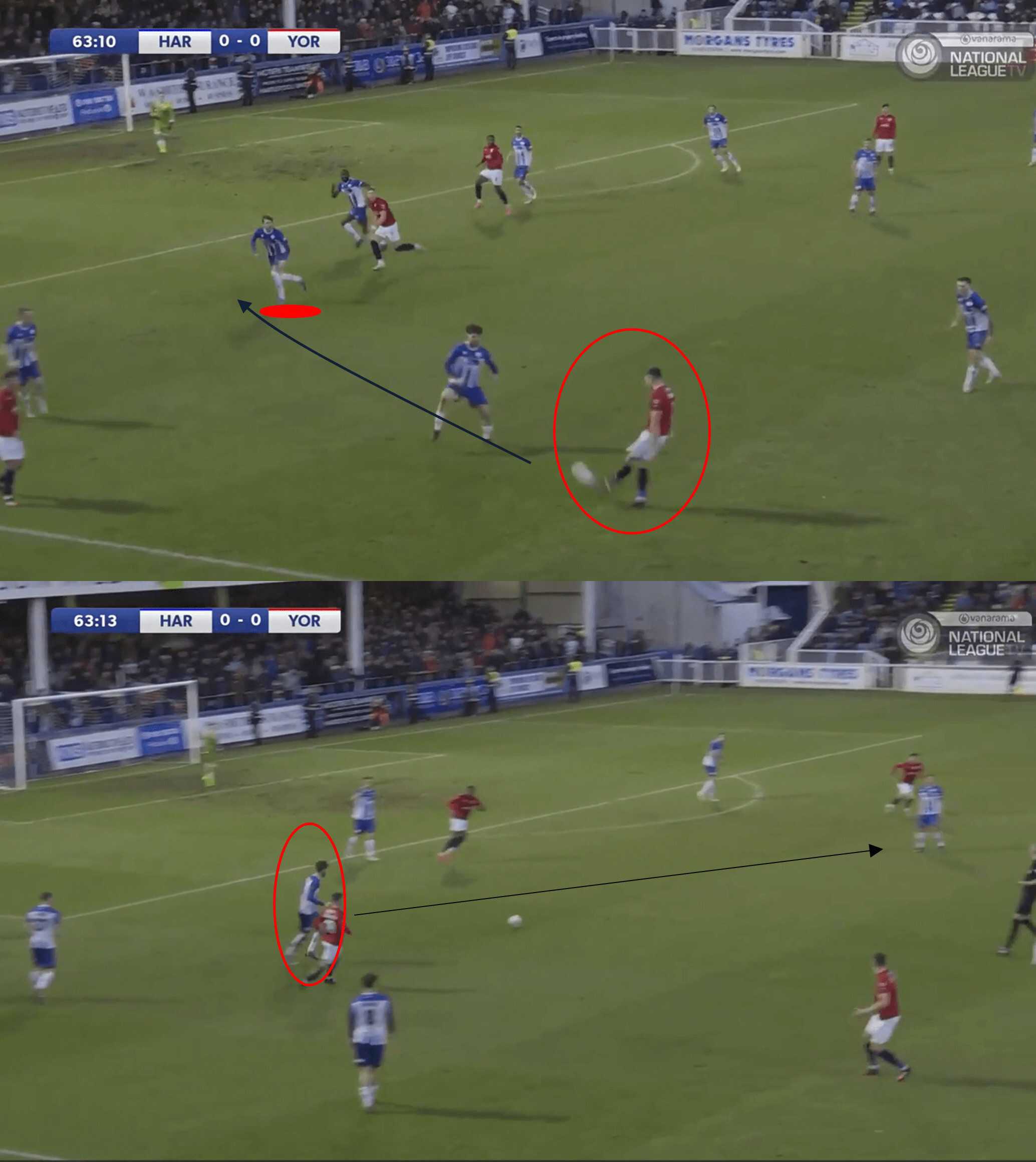
As the ball is played forward by York City, Tom Crawford is able to intercept, control the ball, and play a pass into the central area, as shown. A first-time pass is then played towards Callum Cooke, who, as seen below, is able to drive at the York defence and fire a shot at goal.
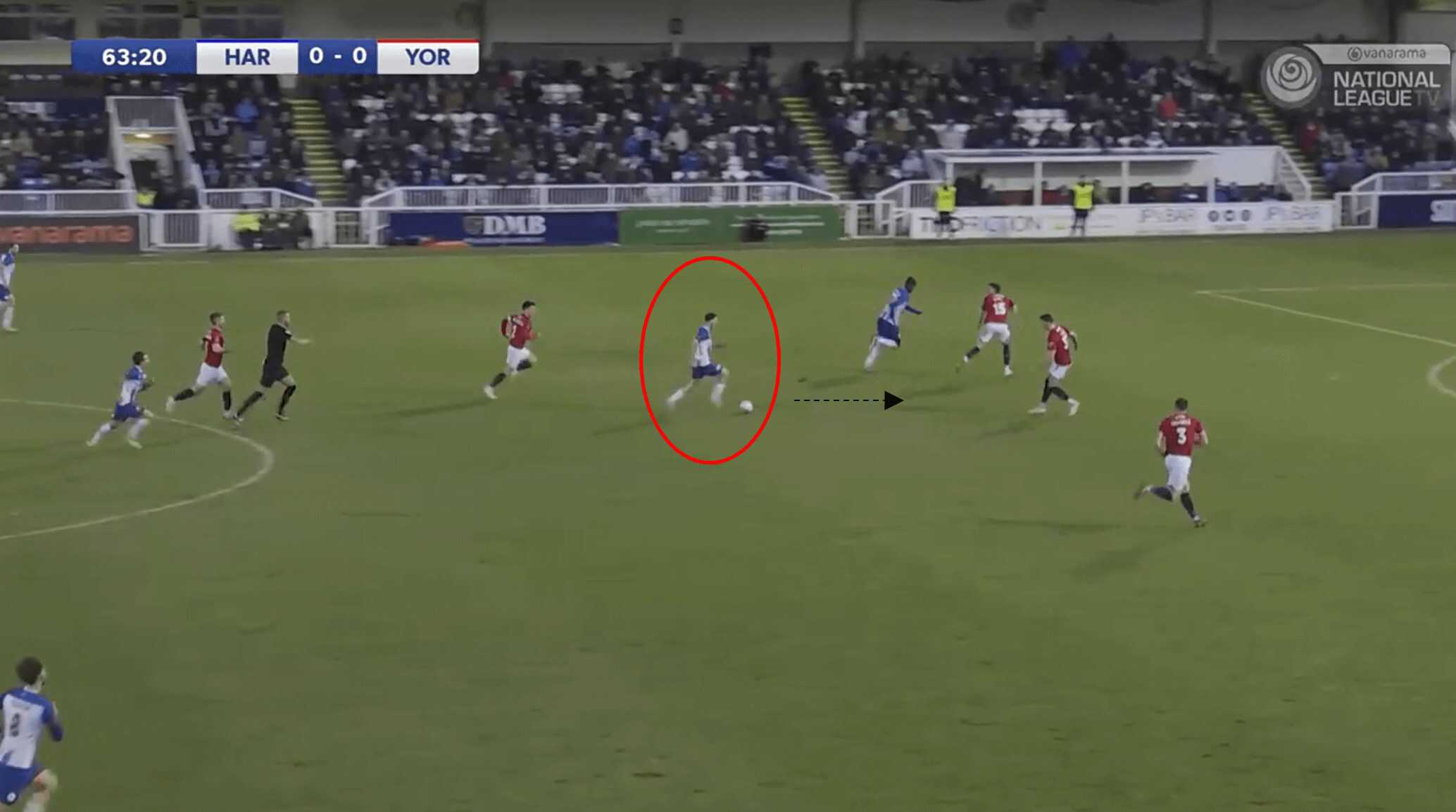
It is, therefore, shown that with a more solid backline, Hartlepool has been able to hit teams on the counter more often. This has provided an extra attacking dimension to their play and made them a greater threat going forward.
Whilst this tactic has proved a useful attacking outlet for the Pools, Phillips has been flexible in utilising this approach. For example, in the fixture against Altrincham, Hartlepool only enjoyed 37% possession and only 41% possession against Woking.
The counterattacking style worked well against Woking; however, it was less effective against Altrincham. Phillips’s side found itself rooted within its own half against the North West side in the first half, and as a result, Hartlepool changed tact for the second half, playing with much more aggression and a faster tempo.
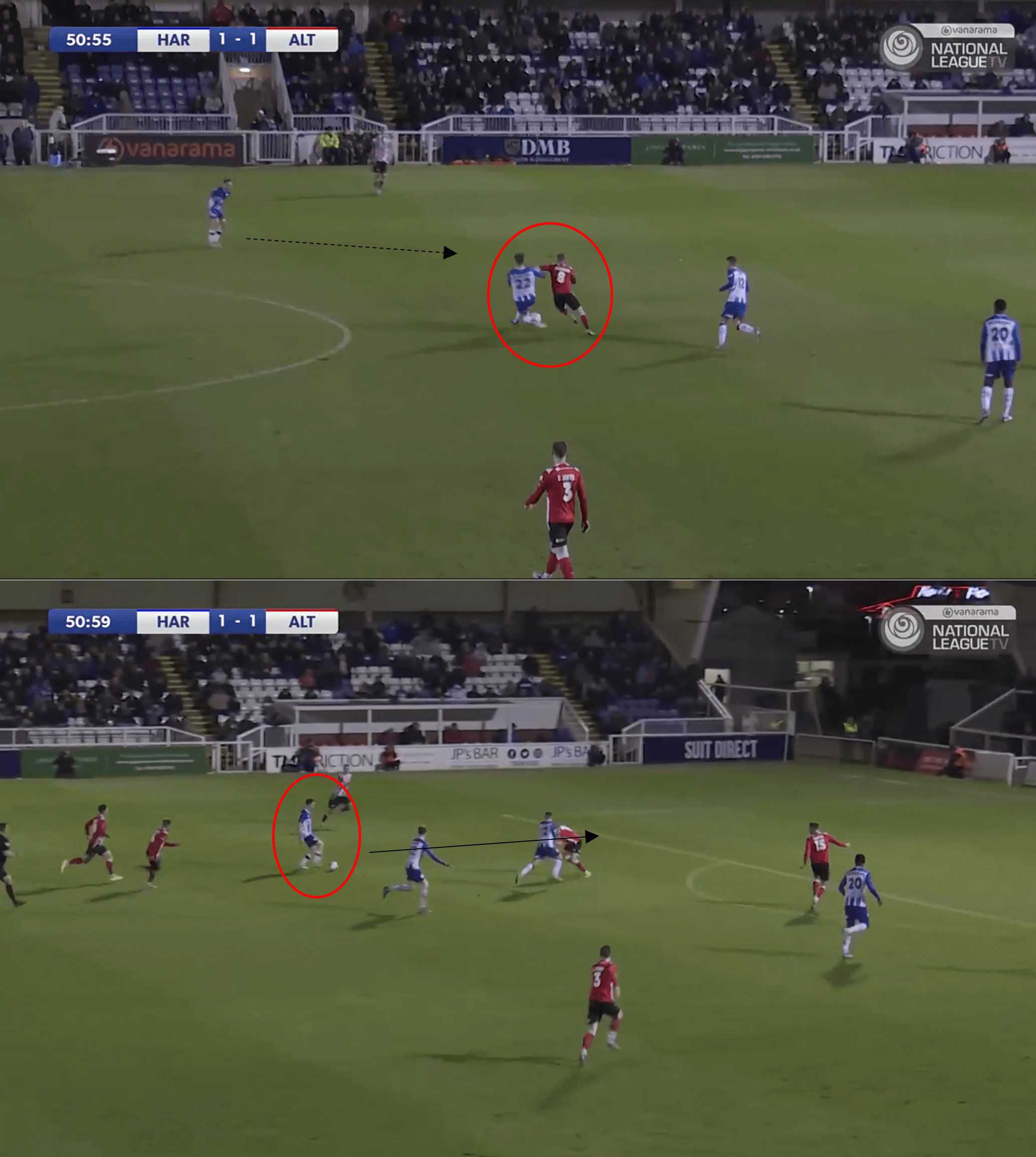
Crawford launches a tackle to retrieve possession. The tackle is well timed to fall to the feet of the advancing Cooke, who then goes on to play a through ball into the penalty area towards Joe Grey. Grey is then brought down by the keeper.
The resulting penalty ensured Hartlepool took the lead, and with two goals in the opening eight minutes of the second half, the game was turned on its head. It indicates the growing confidence at Victoria Park and Phillips’ willingness to change up the tactics depending on how a match is playing out.
Such confidence has been noted by the players, who had said that upon conceding a 91st-minute equaliser to Woking recently, they “would have crumbled” in the past. Instead, Hartlepool hung on for a well-earned point.
Hartlepool has been guilty of gifting goals to the opposition this campaign but with the newfound confidence and tighter defensive unit, there is every hope that such defensive frailties will be left in the past.
Getting crosses into the box
Whilst there have been steady improvements from a defensive point of view, the attacking outlet has been much improved since Phillips’ arrival. This has certainly been helped by forward Emmanuel Dieseruvwe, whose return from injury coincided with Phillips’ arrival.
Dieseruvwe is one of the leading goal-scorers in the division this campaign, having netted 19 times.
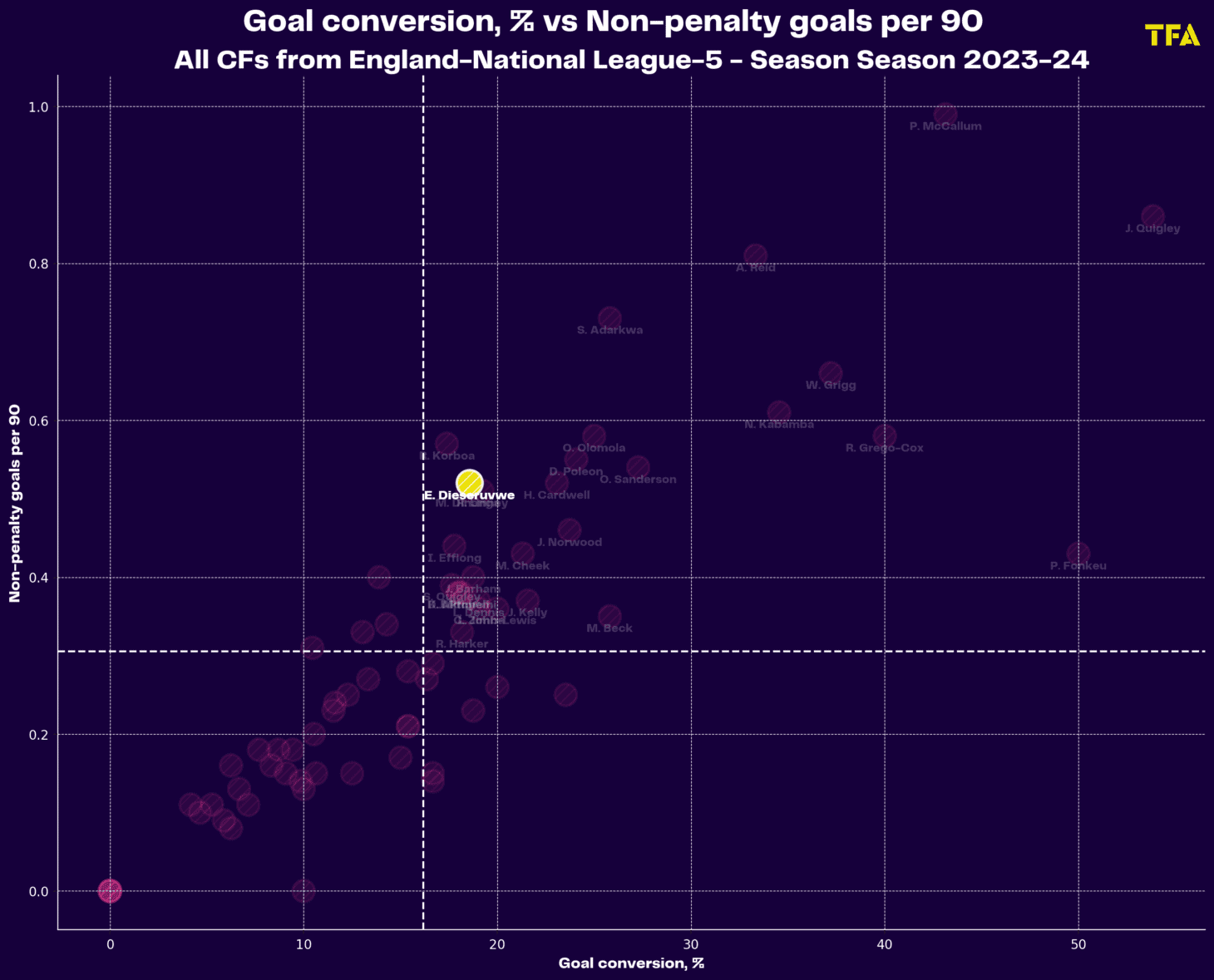
The scatter plot shows that compared to other centre-forwards in England’s fifth tier this season, Dieseruvwe is performing above average in terms of non-penalty shots per 90 as well as goal conversion percentage—this, in turn, points to his strong clinical finishing ability.
Phillips, though, is setting up his side to get the best out of his forward, who has scored two braces and has averaged a goal a game with the former Sunderland forward in the dugout. Dieseruvwe ranks in the top 14% for a percentage of aerial duels won compared to another tier nine forwards. Moreover, as shown below, the forward looks to make runs into the penalty area.
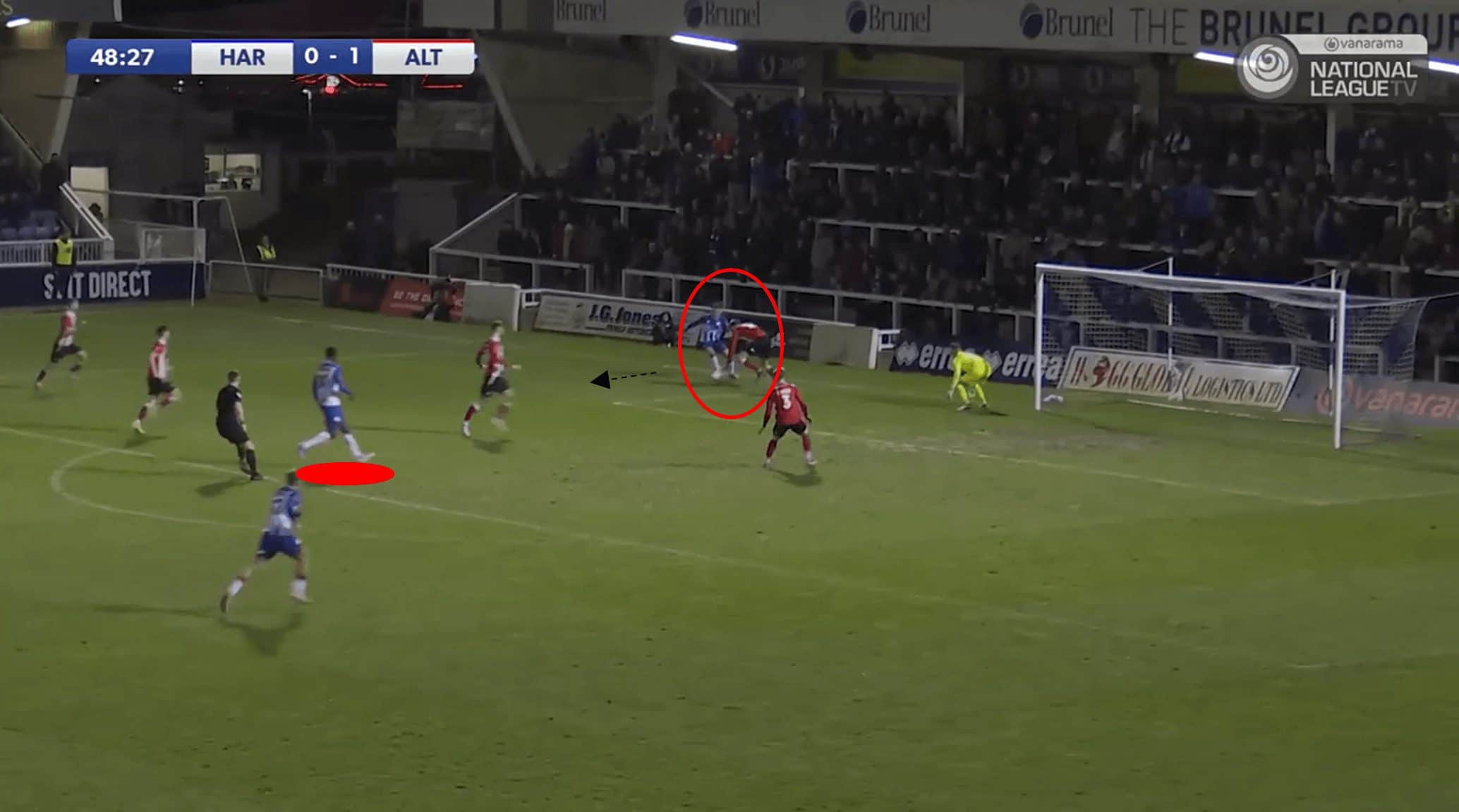
Grey cuts back from the byline, and Dieseruvwe holds his run into the area to provide a passing option. A pass is then played towards the forward, who dispatches a first-time effort on goal.
Phillips’ tactics play to these strengths as an essential factor in Hartlepool’s attacking displays lately has been their ability to use the width of the pitch to get crosses into the area for the likes of Dieseruvwe to attack.
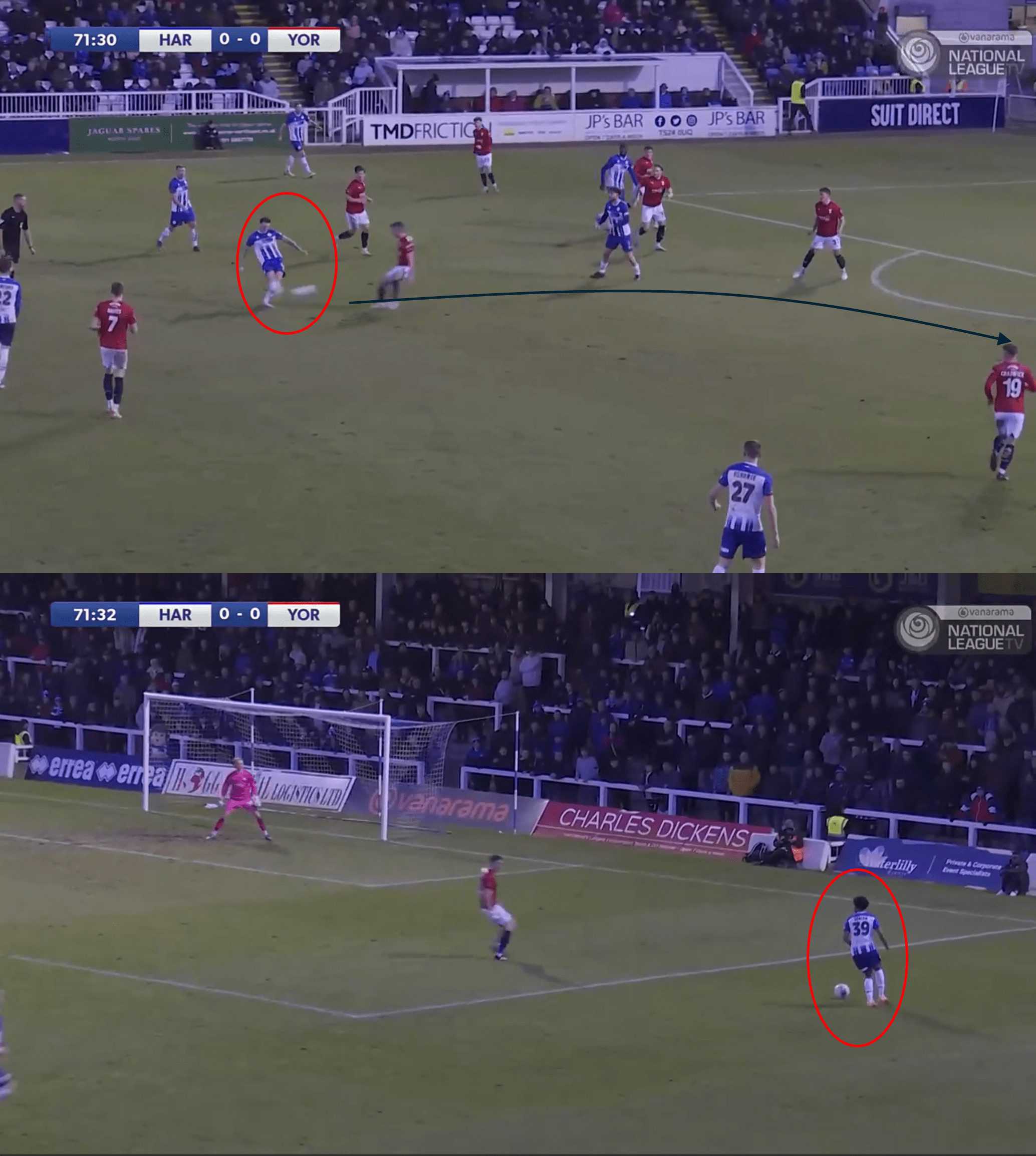
Hartlepool can be patient in looking for an attacking opening and will look to make horizontal passes in the mid to high third, in anticipation of space opening up in the opposition’s defensive line. In the above match stills, as the play is on the left-hand side, more players are drawn to this area, which, in turn, makes it congested.
However, Cooke has the vision to switch play to Courtney Senior on the right. Senior’s cross into the area eventually falls to Dieseruvwe, who fires his side into the lead. It is noticeable in the above example how much space Senior had on the right, giving him time to weigh up his cross. Hartlepool’s patience was rewarded.
With the onus being on using width in the attacking phases, Hartlepool’s crossing has improved following the appointment of Phillips, as shown in the below graphic.
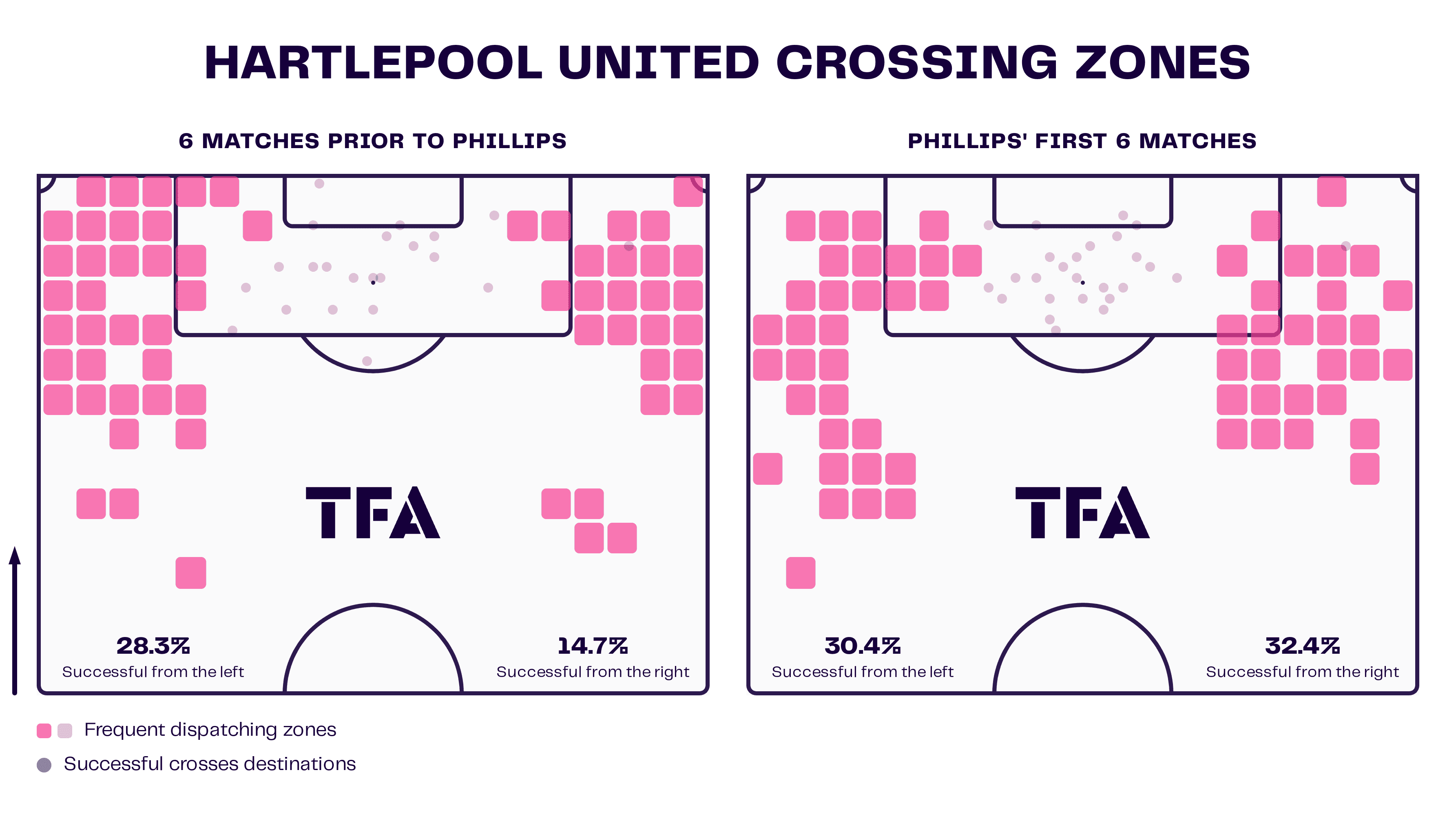
The above compares the six games before Phillips with his first six league games. The percentage of accurate crosses has increased on both flanks, particularly on the right-hand channel, where the percentage of successful crosses has more than doubled. Hartlepool’s attacking outlet has become much more balanced as a result, as they are a threat from either flank.
The Pools are not one-dimensional, though, in their attacking options as they also look to drive forward in more central areas. This is a product of their counterattacking play and the personnel at their disposal, including Grey, who ranks in the 85th percentile for dribbles per 90 this season.
Moreover, Hartlepool has struck a balance in their build-up play lately, switching between steady passing exchanges from the backline and more direct, quick attacks. With Phillips at the helm, the North East side has become a much more exciting prospect. It would seem there are reasons for Pools fans to be optimistic about the future.
Conclusion
In this tactical analysis, we have detailed the turnaround in form at Hartlepool, led by Phillips. The North East outfit has become flexible in their approaches to matches. Whilst they have typically sat deeper, they have not been averse to mixing up their pressing style, looking to play on the front foot given the right opportunity.
Furthermore, a varied attacking approach has led to an increase in tempo, with a greater emphasis on counterattacking, and a strong play on the wings has led to a balanced attack. Phillips seems to be getting the best out of his players at present, and while the playoffs are not impossible this season, regardless, Hartlepool fans will no doubt be looking up the table.
If the Pools can continue on an upward trajectory, a rise up the pyramid and a return to the football league could be on the cards sooner rather than later.






Comments